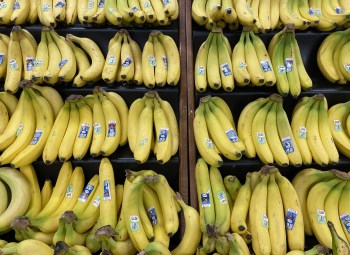
Why you’ll have a hard time buying the “most American fruit”
Why you’ll have a hard time buying the “most American fruit”

Because of today’s global supply chains, and the power of modern science and refrigeration, you can find fruit from practically anywhere in the world in U.S. produce aisles. There is one omission though, and you might not have even heard of it, let alone noticed it was missing: the pawpaw fruit.
Unlike apples and peaches, ubiquitous in U.S. grocery stores, the pawpaw is native to North America. And yet, while you can find dragon fruit and kiwis and all sorts of exotic produce here, you’re not going the find a pawpaw at the grocery store.
Yasmin Tayag, a staff writer for The Atlantic’s science desk, joined “Marketplace’s” Kai Ryssdal to talk about her quest to try one of those elusive pawpaws. An edited transcript of their conversation is below.
Kai Ryssdal: Why does the headline of this piece say, “Why is the most American fruit so hard to buy?” What makes it the most American fruit?
Yasmin Tayag: Oh, the thing about pawpaws that most people don’t realize is that it’s native to this continent. First of all, most people don’t know that pawpaws exist.
Ryssdal: Yeah, full stop. Most people don’t know pawpaws.
Tayag: Yeah, for those who are in the know, they go crazy about it. And what people don’t realize is that they grow wild over large parts of the U.S., all across the Northeast, and even down south toward northern Florida.
Ryssdal: How did you come across a pawpaw?
Tayag: Well, I’m a bit plugged into the foodie world, so I hear people talking about this, like, elusive American fruit all the time. It’s very big in gourmet baking and bartendering as well. But the first time I really engaged with one, with the idea of a pawpaw, was when a cousin living in Windsor, Ontario — that’s right across from Detroit — told me that they grow wild all over the place. She’s like, “People go crazy for them, and yet, they’re just wild fruit. You can eat them from a tree in the park.” And that was what really got me thinking, you know, they’re so in demand, and yet they’re all over the place.
Kai Ryssdal: Well, answer your own question. Because I can go to my local Piggly Wiggly, or any Piggly Wiggly probably within a, well, let me exaggerate only a little bit, 20-mile radius, and they probably would not have pawpaws.
Tayag: That’s probably true. And the main problem with pawpaws is they’re really hard to store and ship. As soon as you pluck them, they get ripe very fast, within three to five days, and they become really squishy and brown and ugly. And so this is the main reason that pawpaw producers say they’re not widely available.
Ryssdal: So really, it’s kind of a marketing and supply chain problem, right? Because nobody’s going to voluntarily buy a brown, squishy, gross fruit.
Tayag: Exactly. But, you know, there is demand. And there are some specialty orchards growing pawpaws that will make the effort to ship these delicate fruits very quickly and get them to these farmers markets.
Ryssdal: Somebody’s going to hear this and come up with some innovative packaging solution, and then we’re going to be inundated with them. I should have asked this at the beginning: What do they look like? And then what do they taste like?
Tayag: Ooh, OK, well, they’re kind of small and greenish, if they’re not already beginning to go squishy, like an avocado. They’re about the size of a dinner roll. And when you slice them open, they’re usually a pale yellow or like a light orange inside, and squishy, and they’ve got little brown seeds inside them.
Ryssdal: You keep saying squishy, and I’m worried about a texture problem. But that’s a whole different thing then. And then what’s the taste like?
Tayag: You know, in a word, I would say tropical. So it’s a little banana-ish, a little bit pineapple, sometimes a little bit of mango. It’s really not what you would expect from a fruit that grows in North America.
Ryssdal: Is there money to be had in these things, do you suppose?
Tayag: I would say that now that there is demand from a certain subset of foodies, there is money to be made. It’s a hot, exciting ingredient much like I guess kale was in the past or even avocados before that.
Ryssdal: OK, kale is not a selling point, let me just say.
Tayag: Speak for yourself.
Ryssdal: OK. Fair enough. So on the theory that you’ve experimented with these things, and on the way out here, what’s your favorite way to eat them, serve them, prepare them, bake them? How do you like them?
Tayag: I really enjoyed scooping it right out of the the fruit. It was like a dessert in a way. Yeah, it was like an exotic treat.
There’s a lot happening in the world. Through it all, Marketplace is here for you.
You rely on Marketplace to break down the world’s events and tell you how it affects you in a fact-based, approachable way. We rely on your financial support to keep making that possible.
Your donation today powers the independent journalism that you rely on. For just $5/month, you can help sustain Marketplace so we can keep reporting on the things that matter to you.

















